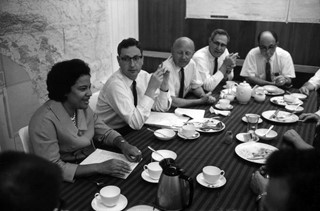Norma Merrick Sklarek, the first licensed African American woman architect in the state of New York, overcame continued racism and sexism throughout her life and career
The history of design is dominated by white men. In a new series titled Forgotten No More, Milly Burroughs shines a light on the influential but often criminally overlooked figures, who left an indelible impact on the field.
- Who are they? Norma Merrick Sklarek
- When were they around? April 15, 1926 – February 6, 2012
- What did they do? Sklarek was a pioneering black female architect
- What are their most celebrated designs? The United States Embassy, Tokyo, Pacific Design Center, Los Angeles, Los Angeles International Airport, Terminal One
- What was their impact? Sklarek overcame widespread racism and sexism to achieve architectural excellence and become the first African American woman elected to the College of Fellows of the American Institute of Architects

In 2008, pioneering architect Norma Merrick Sklarek was honoured with the American Institute of Architects (AIA) Whitney M. Young Jr Award, an accolade given to those deemed to have created outstanding positive change in their field, and one that prompted AIA board member Anthony Costello to declare her “the Rosa Parks of architecture”. Only four years later, in February 2012, Sklarek died of heart failure, marking the end of a remarkable life, but one that is rarely explored in discussions around contemporary architecture.
Born in Harlem on April 14, 1926, Sklarek was perhaps not the most likely of candidates to become an internationally successful architect – due in part to her gender, but also to being the child of Trinidadian parents in the early 20th-century United States. Her most celebrated works include Los Angeles International Airport Terminal One and the US Embassy building in Tokyo, but it is the earth-shattering impact she had on architecture as an institutional entity that ultimately defines her career.
Recognising her aptitude for both mathematics and art, Sklarek’s father encouraged her to consider a career in architecture, following which she attended Barnard College (1944–1945) in order to complete the one year of liberal arts education required to get into Columbia University’s prestigious School of Architecture. The contrast between her lifestyle and those of her classmates soon made it clear to Sklarek that her path into the architecture world would be paved with prejudice and economic disparity, and that she would be required to rely entirely on her own self-belief in order to progress. So that’s exactly what she did.
In 1950 Sklarek was one of only two women, and the only African American in her class, to graduate from Columbia with a degree in archiecture. Despite her already groundbreaking achievements, she was then rejected by 19 firms, undoubtedly the victim of relentless discrimination. Eventually, she accepted a junior draftsperson role in the City of New York’s department of public works, but the job did not fulfill her ambitious goals, so she sat the architecture licensing examination in the hope of progressing her career. Passing the exam on her first attempt, in 1954 Sklarek became the very first licensed African American woman architect in the state of New York.
By 1955 Sklarek had accepted a role at architectural firm Skidmore, Owings & Merrill, also known as SOM. Here she worked on increasingly large-scale projects, alongside which she taught evening classes at New York City Community College. In spite of her busy schedule, which also involved being a single mother of two children, Sklarek became the first African American woman member of the American Institute of Architects in 1959. Later, would relocate to Los Angeles, where one of her sons resided, and began working at Gruen Associates, and in 1962 became the first black woman licensed as an architect in California. Rising to the position of director of architecture, her work with Gruen Associates saw her managing seminal projects for the firm, including the California Mart, Fox Plaza, Pacific Design Center, San Bernardino City Hall, and the US Embassy in Tokyo.
Mirroring the experience of so many women in corporate architecture firms, Sklarek mostly served as a project manager, rather than a design architect. The one exception to this is her work on the US Embassy in Tokyo, with Cesar Pelli, where both parties are recognised as architects. Sklarek continued to collaborate with Pelli on iconic late modern projects such as the Pacific Design Center and the San Bernardino City Hall. Despite amassing an admirable portfolio of work, Sklarek was continually sidelined in client-facing situations, thanks to the archaic and bigoted views of her employers. Subsequently, in 1985 – five years after becoming the first African American woman elected to the College of Fellows of the American Institute of Architects – Sklarek, Margot Siegel and Katherine Diamond co-founded Siegel Sklarek Diamond. At the time, it was the largest woman-owned architectural firm in the US, and Sklarek was the first African American woman to co-own an architectural practice.
